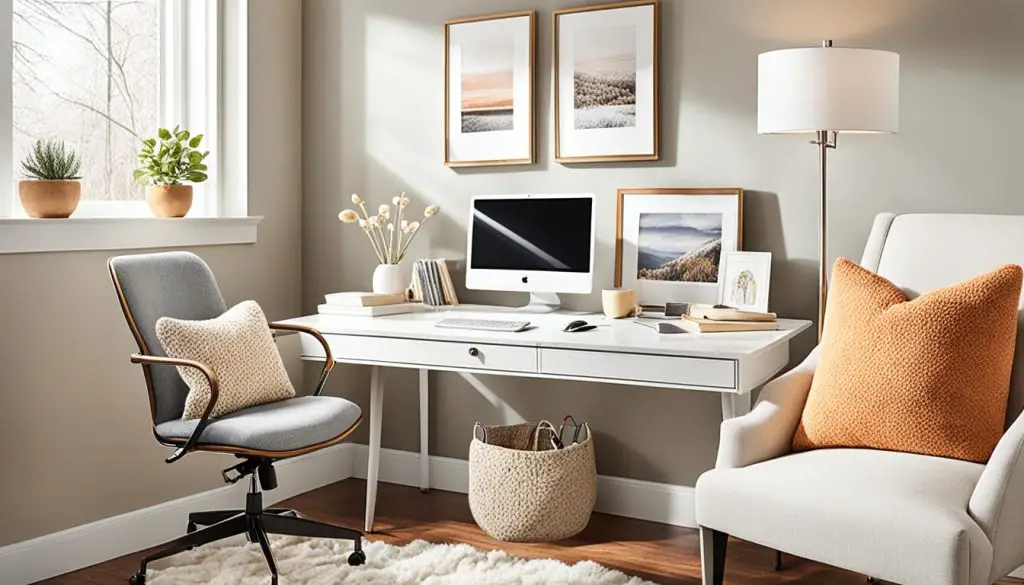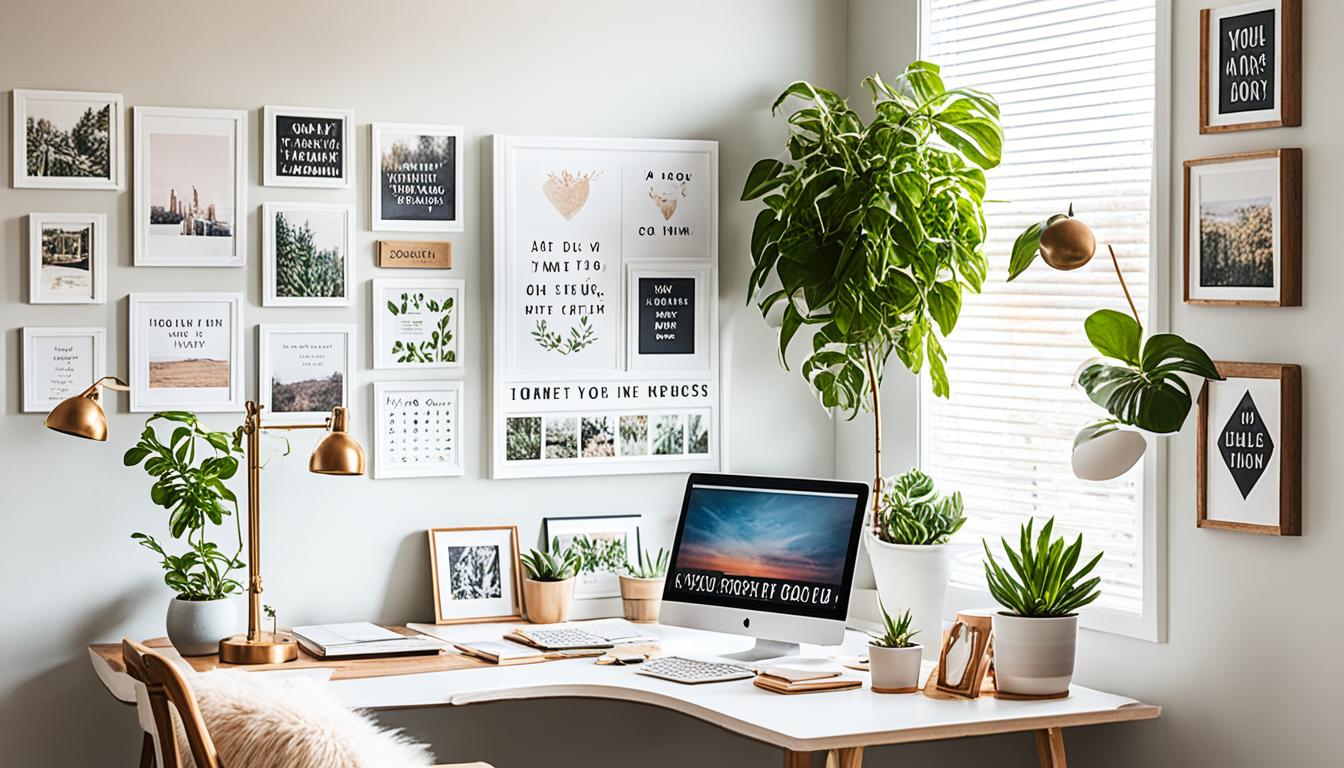Being married to someone who faces endometriosis and fibromyalgia has shown me something important. A well-designed home office can really help her. But what if you have a small budget and no separate office area? Can you still set up a workspace at home that’s good for your health needs?
Working from home brings many pluses, like comfy clothes and doing chores while taking breaks.1 Yet, most of us don’t have a full room for an office. The challenge is to make the best of what you’ve got. An article proposes setting up a work area with just £500. It shows that with smart shopping and a bit of DIY, you can have a beautiful, useful office.1
Designing a home where those with health issues can relax is key, says a second source.2 Things like color, light, and where you put the furniture really matter. They help create a space that improves our health and well-being.2
This piece is all about making your home office work for you without spending a lot. We’ll talk about things like the right furniture and soothing colors. These tips will show you how your office can help you feel better every day.
Introduction to Interior Design for Chronic Illness
Living with a chronic illness can be very tough. It brings both physical and mental pain. This happens while dealing with a lot, like medications and taking care of yourself. Also, people often worry about their loved ones.2
Yet, there is hope. Studies show that special interior design can help ease this struggle. By focusing on wellness and nature in design, homes become places of comfort and healing. For instance, the choice of colors, textures, and where we put furniture matters a lot.2
Adding things like affordable home office decor, comfortable work areas, and designs that are easy to use can do wonders. Especially for those dealing with migraines, chronic pain, depression, and cancer. It not only makes working at home easier but also helps cope with the changing environment of someone with a disability.2
This all-inclusive design approach makes living and working at home better. It tackles the physical, mental, and emotional hurdles of chronic diseases. Thus, it provides a safe and relieving space within the house.2
Designing your space with special furniture and smart office choices can be a game-changer. It aims to help with daily pain and tiredness, making work better for those with special needs. This way, we are creating more than just a workspace. We form a place that supports well-being in all its forms.2
What is Chronic Illness?
Chronic illnesses can really mess with your body, mind, and how you connect with others. It’s not fun and can stick around for a long time. These issues can alter every aspect of life, from how you feel to how you interact with others.
Types of Chronic Illnesses
They include things like migraines, chronic pain, depression, cancer, and more. Chronic pain lasts over 3 months and can seriously shake up everyday life.2
Impact on Physical and Mental Well-being
Chronic illnesses make it hard to do things, bring pain and tiredness, and can make you feel very low. They touch every part of our well-being, not just our bodies.
For example, migraines are intense headaches that last a long time. They come with nausea, light or sound sensitivity, and more.
Handling chronic diseases means setting up your life to be healthy and easy. This includes having lots of light, easy healthcare access, and comfy furniture. The goal is to be as healthy and happy as possible through good choices and living well.2
Affordable Home Office Decor Chronic Illness
I’ve faced the challenge of setting up a home office on a tight budget. I’ve seen the big effect Ergonomic Workspaces and Accessible Design. I enjoy helping people make their home offices nice without spending too much. Recently, I did a project where I had £500 to make a great home office space1. I used items from regular shops and did some creative work. The office turned out beautifully. It was inspired by nature and made to be great for working and for people with special needs.
Setting up a good work spot doesn’t always need a lot of money or extra space. With some clever ideas, anyone can make their own special work area. For my client, we used simple colors, a bit of plants, and natural materials. This made the place feel friendly and helped manage any pains or discomforts.
Our goal was to make a relaxing and calming spot in their home. This spot could help lessen tiredness and stress. We turned a small part of their living room into a special work area. It supported their health and made a big difference. The end result was not just a home office. It was a place that made working better for them, showing everyone that a nice, health-focused work space is possible on any budget.
The Role of Residential Design in Chronic Illness
Living with a chronic illness makes your home very important. The right design changes can lower stress and raise happiness. It’s key for your living space to meet your unique needs, offering calm and comfort.3
Reducing Stress Through Design
Design that focuses on health can make a big difference. It aims to make your home a good place for your body and mind. By creating spaces that help you relax and connect with others, along with using safe materials, it improves your daily life.3
Creating Supportive Environments
It’s all about key design choices. These can make your home a healing place. Things like good smells and air, along with a nature-friendly style, help you feel better.3
Designing with health in mind is crucial for people with chronic sickness. It’s not just about the look, but also how your home makes you feel. These changes can turn your place into a safe haven from the struggles of sickness.3
Holistic Design for Wellness
Holistic interior design focuses on making spaces good for your body and mind.4 It mixes calming colors, lots of natural light, and fresh air with comfy furniture.2 The main aim is to make a place that helps people feel better, especially if they deal with conditions like migraines or depression.2
It helps people with health issues feel better by designing thoughtful spaces.4 Everything from the colors on the walls to where plants are put matters.4
This design is all about focusing on health to prevent sickness.2 It uses spaces to help improve physical and mental health, and to bring more balance and strength.2
By using the right light, furniture, and nature themes, we can make life better for those with health problems.24 It shows that individual needs and a peaceful environment can lead to a happier life.4
Migraines and Interior Design
Migraines are more than just headaches; they’re a neurological condition. They bring throbbing pain, nausea, and make you sensitive to light or sound. You might see strange patterns, feel dizzy, confused, and tired. These symptoms can really affect your daily life. Working on the design of your home can be a big help for those managing migraines.
Lighting for Migraines
For a space that helps with migraines, think about the light. It’s key to lessen the glare and brightness. Use dimmers, pick soft lights, and avoid fluorescent bulbs. These steps can make a room feel better for someone with migraines. The right lighting design can ease their symptoms and help make their everyday life better.
Color Therapy
Color also plays a big role in managing migraines. Using the right colors can make a space feel calming. Shades of blue and green are particularly good for this. A well-thought-out color plan by interior designers can help reduce stress. It can make the surroundings feel more peaceful and reduce the chance of symptoms getting worse.

Chronic Pain and Interior Design
Living with chronic pain, such as fibromyalgia, osteoarthritis, or chronic back pain, calls for smart interior design choices. These can really help fight the symptoms and boost comfort.2 A detailed look points out how picking the right furniture and setup is key for people managing this kind of pain.
Ergonomics for Chronic Pain
For those with chronic pain, adjustable furniture is a big win. It assists in keeping good posture and cutting down on aches and pains.5 Back in 2003, a study on ergonomics found that folks using ergonomic chairs felt better and were almost 18% more productive.5 So, setting up your space with these types of items can do wonders for your focus and comfort.
Texture and Pattern Considerations
The way things feel and look matters a lot, too. The advice is to pick textures and patterns that calm the senses and bring comfort, especially for those in pain.2 Some specific fabrics and patterns can create a peaceful vibe, helping reduce the ache felt by people with chronic pain.
Mental Health and Interior Design
The second source talks about how interior design affects mental health. It says things like colors, layout, and nature elements can really help. These elements can make people feel better emotionally.2 Chronic illnesses like migraines, chronic pain, and depression can really hurt how we feel, socialize, and even physically.2
Color Psychology
Choosing calming colors can help those with depression, the article suggests.2 Chronic diseases mess with many parts of our life, like our body, feelings, how we connect with others, and even money.2 Using soft colors and avoiding bright ones can make our homes peaceful and calming. This is good for feeling better and finding peace.
Biophilic Design Principles
The second source also talks about getting enough natural light and adding plants indoors. These things are part of biophilic design and they’re key for good mental health.2 Managing chronic illnesses means day-to-day care and healthy choices.2 Adding indoor plants and using natural materials can make a space healing. It helps clear away some of the stress chronic illnesses bring.
The Role of Nature in Biophilic Design
Biophilic design brings nature indoors, which is great for those dealing with chronic illnesses. It uses natural light, sounds, and materials like wood and stone.
Natural Light and Sound
Natural light and sounds help both our bodies and minds.6 They make us feel better, especially on dark winter days.6 But too much light can mess up our sleep.6 By mixing light and sound, biophilic design makes spaces peaceful and stress-free.
Benefits of Natural Materials
Choosing natural materials is a big part of biophilic design.6 These items like wood and stone make a home feel cozy and connected to nature.6 They help create a tranquil space for those with ongoing health problems, too.6 Natural colors are also popular, offering a calming vibe.
Color, Texture, and Well-being
The second source points out how important color, texture, and materials are in interior design. This is especially crucial for those with chronic illnesses. These design features affect how we feel and sense our environment. They are key in making spaces that help our health in every way.
Color and Emotional Responses
Choosing the right colors can make a big difference. It’s key for people with conditions like migraines, chronic pain, or depression. Designers pick colors to bring calm and relaxation. This helps with overall well-being, addressing people’s emotional needs.
Texture and Tactile Experiences
Textures can also change how a room feels. They matter a lot for those with chronic illnesses. Using soft fabrics and natural materials can help. It makes their living space more comforting and healing. This meets the specific needs of people struggling with health issues.

When designers blend color, texture, and materials carefully, they do more than just make a room look good. They can boost our health on many levels, offering mental and emotional support. This kind of design truly changes lives, offering a place of safety and recovery at home.
Self-Care Practices and Interior Design
Living with chronic illnesses means we must take extra care of ourselves. It matters a lot to focus on things that help our body, mind, and emotions. The way our homes are designed can really support this too. It’s about making our space a place where healing and rest are easy.
Creating Restorative Spaces
Interior designers have a big role in this. They can make our homes into places that are calm, relaxing, and mindful. By adding comfy spots, soft colors, and bits of nature, we create a personal sanctuary. It helps us relax and improve our health. Things like quiet reading corners, meditation areas, or peaceful gardens can be key places for taking care of ourselves.
Promoting Mindfulness
Practices like meditation and deep breathing are great for those with long-term illnesses. Our home design can also encourage this. It creates spaces that make us feel focused and peaceful. Being close to nature, using calming light, and having quiet spots helps us feel more in the moment. This can be a huge help when life gets hard because of our health.
We can work with designers who understand what we need because of our health. They can help make our home a place that helps with our care and wellness. These revitalized spaces can be our personal sanctuaries. They’re where we go to rest, recharge, and build the strength we need to face our health problems every day.
Affordable Home Office Solutions
Creating a home office that’s both affordable and functional can be a big challenge. Yet, I’ve found it’s not impossible. With a bit of creativity and resourcefulness, anyone can turn a small budget into a wellness-focused work spot.7
My journey involved mixing high street bargains with DIY projects. This strategy helped me set up a work-friendly space at home. It meets the extra needs I have because of my chronic illness. The focus on getting natural light, organizing the reach zone, and keeping things tidy really hit home for me.7
Also, putting my goals in plain sight, using an ultrawide monitor, and adding nature around my work area have been game-changers. They’ve upped my efficiency, creativity, and mood. By following these tips and sticking to smart, affordable designs, I’ve built a home office that not only supports my health but looks good too.7,8,9
Source Links
- https://homewithkelsey.com/home-office-makeover/
- https://www.julieannrachelle.com/blended-decor-blog/wellness-design-for-chronic-illness
- https://www.healthdesign.org/insights-solutions/healthcare-home-white-paper
- https://www.wellable.co/blog/wellness-room-in-the-workplace/
- https://todoist.com/inspiration/home-office-upgrades
- https://www.thegirlwiththegreensofa.com/home/2019/5/30/biophillic-design
- https://www.makerstations.io/best-desk-setup-ideas/
- https://www.businessinsider.com/guides/home/useful-desk-accessories
- https://www.nytimes.com/2020/04/08/smarter-living/ergonomic-office-equipment-work-from-home.html
